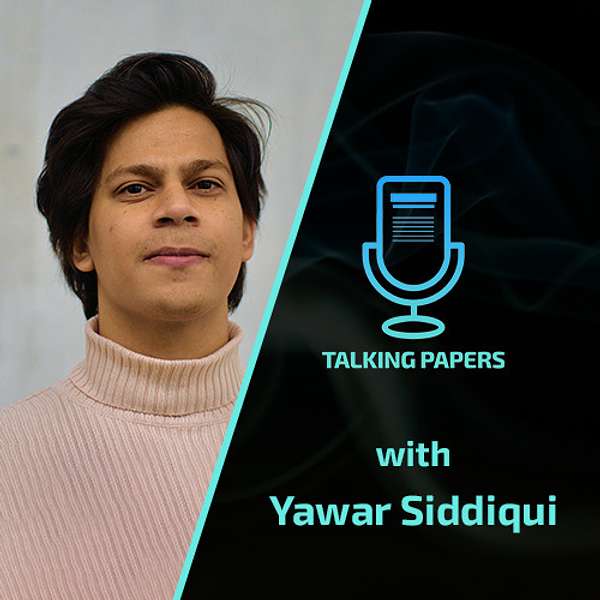
Talking Papers Podcast
🎙️ Welcome to the Talking Papers Podcast: Where Research Meets Conversation 🌟
Are you ready to explore the fascinating world of cutting-edge research in computer vision, machine learning, artificial intelligence, graphics, and beyond? Join us on this podcast by researchers, for researchers, as we venture into the heart of groundbreaking academic papers.
At Talking Papers, we've reimagined the way research is shared. In each episode, we engage in insightful discussions with the main authors of academic papers, offering you a unique opportunity to dive deep into the minds behind the innovation.
📚 Structure That Resembles a Paper 📝
Just like a well-structured research paper, each episode takes you on a journey through the academic landscape. We provide a concise TL;DR (abstract) to set the stage, followed by a thorough exploration of related work, approach, results, conclusions, and a peek into future work.
🔍 Peer Review Unveiled: "What Did Reviewer 2 Say?" 📢
But that's not all! We bring you an exclusive bonus section where authors candidly share their experiences in the peer review process. Discover the insights, challenges, and triumphs behind the scenes of academic publishing.
🚀 Join the Conversation 💬
Whether you're a seasoned researcher or an enthusiast eager to explore the frontiers of knowledge, Talking Papers Podcast is your gateway to in-depth, engaging discussions with the experts shaping the future of technology and science.
🎧 Tune In and Stay Informed 🌐
Don't miss out on the latest in research and innovation.
Subscribe and stay tuned for our enlightening episodes. Welcome to the future of research dissemination – welcome to Talking Papers Podcast!
Enjoy the journey! 🌠
#TalkingPapersPodcast #ResearchDissemination #AcademicInsights
Talking Papers Podcast
Panoptic Lifting - Yawar Siddiqui
In this episode of the Talking Papers Podcast, I hosted Yawar Siddiqui to chat about his CVPR 2023 paper "Panoptic Lifting for 3D Scene Understanding with Neural Fields".
All links are available in the blog post.
In this paper, they proposed a new method for "lifting" 2D panoptic segmentation into a 3D volume represented as neural fields using in-the-wild scene images. While the semantic segmentation part is simply represented as an MLP, the instance indices are very difficult to keep track of in between the different frames. This is solved using a Hungarian algorithm and a set of custom losses.
Yawar is currently a PhD student at the Technical University of Munich (TUM) under the supervision of Prof. Matthias Niessner. This work was done as part of his latest internship with Meta Zurich. It was a pleasure chatting with him and I can't wait to see what he cooks up next.
AUTHORS
Yawar Siddiqui, Lorenzo Porzi, Samuel Rota Bulò, Norman Müller, Matthias Nießner, Angela Dai, Peter Kontschieder
ABSTRACT
We propose Panoptic Lifting, a novel approach for learning panoptic 3D volumetric representations from images of in-the-wild scenes. Once trained, our model can render color images together with 3D-consistent panoptic segmentation from novel viewpoints. Unlike existing approaches which use 3D input directly or indirectly, our method requires only machine-generated 2D panoptic segmentation masks inferred from a pre-trained network. Our core contribution is a panoptic lifting scheme based on a neural field representation that generates a unified and multi-view consistent, 3D panoptic representation of the scene. To account for inconsistencies of 2D instance identifiers across views, we solve a linear assignment with a cost based on the model's current predictions and the machine-generated segmentation masks, thus enabling us to lift 2D instances to 3D in a consistent way. We further propose and ablate contributions that make our method more robust to noisy, machine-generated labels, including test-time augmentations for confidence estimates, segment consistency loss, bounded segmentation fields, and gradient stopping. Experimental results validate our approach on the challenging Hypersim, Replica, and ScanNet datasets, improving by 8.4, 13.8, and 10.6% in scene-level PQ over state of the art.
SPONSOR
This episode was sponsored by YOOM. YOOM is an Israeli startup dedicated to volumetric video creation. They were voted as the 2022 best start-up to work for by Dun’s 100.
Join their team that works on geometric deep learning research, implicit representations of 3D humans, NeRFs, and 3D/4D generative models.
Visit YOOM
For job opportunities with YOOM visit https://www.yoom.com/careers/
CONTACT
If you would like to be a guest, sponsor or just share your thoughts, feel free to reach out via email: talking.papers.podcast@gmail.com
This episode was recorded on July 6th, 2023.
#talkingpapers #CVPR2023 #PanopticLifting #NeRF #TensoRF #AI #Segmentation #DeepLearning #MachineLearning #research #artificialintelligence #podcasts #MachineLearning #research #artificialintelligence #podcasts
🎧Subscribe on your favourite podcast app: https://talking.papers.podcast.itzikbs.com
📧Subscribe to our mailing list: http://eepurl.com/hRznqb
🐦Follow us on Twitter: https://twitter.com/talking_papers
🎥YouTube Channel: https://bit.ly/3eQOgwP
